
Nanjing, alternatively romanized as Nanking, is the capital of Jiangsu province of the People's Republic of China. It is a sub-provincial city, and a megacity. The city has 11 districts, an administrative area of 6,600 km2 (2,500 sq mi), and a population of 9,423,400 as of 2021. Situated in the Yangtze River Delta region, Nanjing has a prominent place in Chinese history and culture, having served as the capital of various Chinese dynasties, kingdoms and republican governments dating from the 3rd century to 1949, and has thus long been a major center of culture, education, research, politics, economy, transport networks and tourism, being the home to one of the world's largest inland ports. The city is also one of the fifteen sub-provincial cities in the People's Republic of China's administrative structure, enjoying jurisdictional and economic autonomy only slightly less than that of a province. Nanjing has been ranked seventh in the evaluation of "Cities with Strongest Comprehensive Strength" issued by the National Statistics Bureau, and second in the evaluation of cities with most sustainable development potential in the Yangtze River Delta. It has also been awarded the title of 2008 Habitat Scroll of Honor of China, Special UN Habitat Scroll of Honor Award and National Civilized City. Nanjing is also considered a Beta city classification, together with Chongqing, Hangzhou and Tianjin by the Globalization and World Cities Research Network, and ranked as one of the world's top 100 cities in the Global Financial Centres Index.
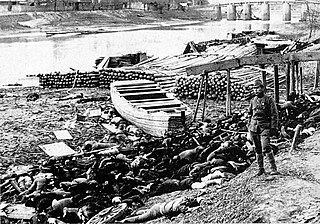
The Nanjing Massacre or the Rape of Nanjing was the mass murder of Chinese civilians in Nanjing, the capital of the Republic of China, immediately after the Battle of Nanking in the Second Sino-Japanese War, by the Imperial Japanese Army. Beginning on December 13, 1937, the massacre lasted six weeks. The perpetrators also committed other war crimes such as mass rape, looting, and arson. The massacre is considered to be one of the worst wartime atrocities.

The Battle of Nanking was fought in early December 1937 during the Second Sino-Japanese War between the Chinese National Revolutionary Army and the Imperial Japanese Army for control of Nanjing (Nanking), the capital of the Republic of China.
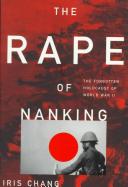
The Rape of Nanking: The Forgotten Holocaust of World War II is a bestselling 1997 non-fiction book written by Iris Chang about the 1937–1938 Nanjing Massacre — the mass murder and mass rape of Chinese civilians committed by the Imperial Japanese Army in Nanjing, the capital of the Republic of China, immediately after the Battle of Nanjing during the Second Sino-Japanese War. It describes the events leading up to the Nanjing Massacre, provides a graphic detail of the war crimes and atrocities committed by Japanese troops, and lambastes the Japanese government for its refusal to rectify the atrocities. It also criticizes the Japanese people for their ignorance about the massacre. It is one of the first major English-language books to introduce the Nanjing Massacre to Western and Eastern readers alike, and has been translated into several languages. The book significantly renewed public interest in Japanese wartime conduct in China, Korea, the Philippines, Southeast Asia, and the Pacific.
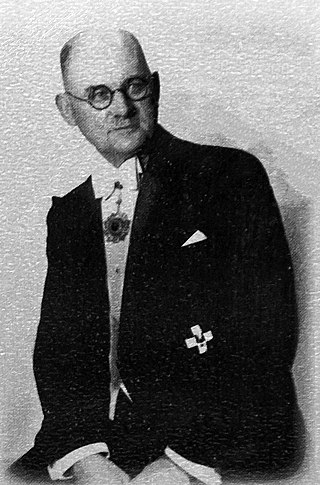
John Heinrich Detlef Rabe was a German businessman and Nazi Party member best known for his efforts to stop war crimes during the Japanese Nanjing Massacre and his work to protect and help Chinese civilians during the massacre that ensued. The Nanking Safety Zone, which he helped to establish, sheltered approximately 250,000 Chinese people from being killed. He officially represented Germany and acted as senior chief of the European-U.S. establishment that remained in Nanjing, the Chinese capital at the time, when the city fell to the Japanese troops.

The Nanking Incident occurred in March 1927 during the capture of Nanjing by the National Revolutionary Army (NRA) in their Northern Expedition. Foreign warships bombarded the city to defend foreign residents against rioting and looting. Several ships were involved in the engagement, including vessels of the Royal Navy and the United States Navy. Marines and sailors were also landed for rescue operations including some 140 Dutch forces. Both Nationalist and Communist soldiers within the NRA participated in the rioting and looting of foreign-owned property in Nanjing.

Wilhelmina "Minnie" Vautrin was an American missionary, diarist, educator and president of Ginling College. She was a Christian missionary in China for 28 years. She is known for the care and protection of at least 10,000 Chinese refugees during the Nanking Massacre in China, at times even challenging the Japanese authorities for documents in an attempt to protect the civilians staying at her college.
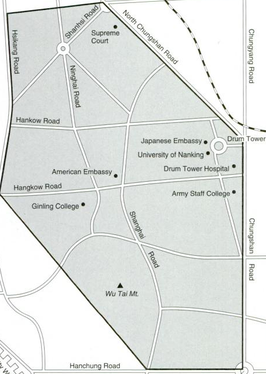
The Nanking Safety Zone was a demilitarized zone for Chinese civilians set up on the eve of the Japanese breakthrough in the Battle of Nanking. Following the example of Jesuit Father Robert Jacquinot de Besange in Shanghai, the foreigners in Nanjing created the Nanking Safety Zone, managed by the International Committee for the Nanjing Safety Zone led by German businessman and Nazi party member John Rabe. The zone and the activities of the International Committee were responsible for safely harboring 250,000 Chinese civilians from death and violence during the Nanjing Massacre.
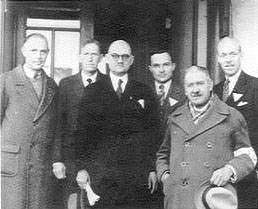
The International Committee was established in 1937 to establish and manage the Nanking Safety Zone.

The Good Man of Nanking: The Diaries of John Rabe is a collection of the personal journals of John Rabe, a German businessman who lived in Nanjing at the time of the Nanjing Massacre in 1937–1938. The book contains the diaries that Rabe kept during the Nanjing Massacre, writing from his personal experience and observation of the events that took place. It also excerpts Rabe's experience in immediate post-war Berlin, then occupied by Soviet troops. Rabe's diaries were made known and quoted by author Iris Chang during the research for her book, The Rape of Nanking; they were subsequently translated from German to English by John E. Woods and published in the United States in 1998. The diaries of Rabe could only provide witnesses of a small corner of the Nanjing Massacre, because of the limitation of his activity in the safe zone.

The Memorial Hall of the Victims in Nanjing Massacre by Japanese Invaders is a museum to memorialize those that were killed in the Nanjing Massacre by the Imperial Japanese Army in and around the then-capital of China, Nanjing, after it fell on December 13, 1937. It is located in the southwestern corner of downtown Nanjing known as Jiangdongmen (江东门), near a site where thousands of bodies were buried, called a "pit of ten thousand people".

John Rabe is a 2009 biographical film directed by Florian Gallenberger, based upon John Rabe's published wartime diaries.
Don't Cry, Nanking, also known as Nanjing 1937, is a 1995 Chinese film about the 1937 Nanjing Massacre committed by the Imperial Japanese Army in the former capital city Nanjing, China.

The John Rabe House (拉贝故居), located at Xiaofenqiao No. 1 (小粉桥1号) in Nanjing, China, was where John Rabe stayed during the Nanking Massacre and protected more than 600 Chinese refugees in this house, and within its garden, from Japanese persecution. Today it accommodates the “John Rabe and International Safety Zone Memorial Hall” and the “John Rabe Research and Exchange Centre for Peace and Reconciliation.”
Nanjing Massacre denial is the denial of the fact that Imperial Japanese forces murdered hundreds of thousands of Chinese soldiers and civilians in the city of Nanjing during the Second Sino-Japanese War, an extremely controversial episode in the history of Sino-Japanese relations. Most historians accept the findings of the Tokyo tribunal with respect to the scope and nature of the atrocities which were committed by the Imperial Japanese Army after the Battle of Nanjing. In Japan, however, there has been a debate over the extent and nature of the massacre with some historians attempting to downplay or outright deny that the massacre took place.
Lewis Strong Casey Smythe [pronounced "Smith"] was a sociologist and an American Christian missionary to China who was present during the Nanjing Massacre.

Nanjing University is a national public university in Nanjing, Jiangsu, China. It is affiliated and sponsored by the Ministry of Education. The university is part of the Double First Class University Plan, Project 985, and Project 211.
Nanjing University Medical School, the Medical School of Nanjing University, is one of the major practical and professional schools of Nanjing University. The division of basic medicine is located in Xianlin campus, and division of clinical medicine in Gulou campus which is located in the centre of Nanjing.
The following is a timeline of the history of the city of Nanjing, Jiangsu Province, China.

Hubert Lafayette Sone, (1892–1970), also known as SoongHsu-Peh in Chinese, was an American Methodist missionary in China. He was a professor of Old Testament at Nanjing Theological Seminary during the Japanese invasion in 1937. Sone was among the small group of foreigners who remained in the city and provided aid to the Chinese victims of the Japanese atrocities. He served with John Rabe on the International Committee for the Nanking Safety Zone and was Associate Food Commissioner. On 18 February 1938 the name of the committee was changed to the "Nanjing International Relief Committee." After the departure of George Fitch, Sone was elected Director of the Nanjing International Relief Committee. For their actions in support of the Chinese people, Sone and thirteen other Americans were awarded "The Order of the Blue Jade" by the Chinese government.














